WASHINGTON — While the American Trucking Associations (ATA) estimates in 2022 that the truck driver shortage will remain near its historical high at nearly 78,000 drivers, other industry leaders say that there is no shortage at all.
According to a new report, the ATA calculates its shortage estimates by determining the difference between the number of drivers currently in the market and the optimal number of drivers based on freight demand,
ATA’s 2022 projection is the second highest level on record after 81,258 in 2021.
While all sectors in the industry struggle with finding enough qualified drivers, the driver shortage is most acute in the longer-haul (i.e., non-local) for-hire truckload market.
ATA contends that there is no single cause of the driver shortage, but some of the primary factors include:
- High average age of current drivers, which leads to a high number of retirements.
- Women make up just 8% of all drivers, well below their representation in the total
workforce of 47%. - Inability of some would-be and current drivers to pass a drug test.
- Other barriers to entry such as minimum driving age, driving history and criminal
background. - Lifestyle disadvantages, especially in the longer-haul market with greater time away from
home. - Infrastructure and other issues, like a lack of truck parking spots, which causes drivers to
stop driving earlier than they need to so they can get a spot for the night, and congestion
which limits drivers’ ability to safely and efficiently make deliveries.
At current trends, the shortage could surpass 160,000 in 2031, according to the ATA.
This forecast is based on driver demographic trends, including gender and age, as well as expected freight growth.
As part of this study, ATA estimates that over the next 10 years, the industry will have to recruit nearly 1.2 million new drivers into the industry to replace retiring drivers, drivers that leave voluntarily (e.g., lifestyle) or involuntarily (e.g., driving records or failed drug test), as well as additional drivers needed for industry growth.
“These trends are notwithstanding the impact of potential regulations or laws in the future, either positive, such as lowering the minimum age of eligibility for a commercial driver’s license, or negative, which could lower productivity per driver resulting in more drivers needed to haul the same amount of freight,” the ATA report stated. “Because there is no single cause of the driver shortage, that means there is no single solution.”
The ATA says that one trend is that driver pay and earnings are going up significantly.
Data from ATA, which was released earlier this year, showed that the average truckload driver made over $69,000 in 2021, including salaries and bonuses but not benefits. This figure reflects an 18% increase in annual compensation from 2019.
This data also showed that over 90% of truckload carriers raised driver pay in 2021. Data from the Department of Labor shows that average annual earnings of production and non-supervisory
employees, with the vast majority of those being driver occupations, in the general freight, long-haul for-hire truckload industry increased 7.5% on average per year over the last two and a half years, compared to 2.6% in the 10 years preceding.
“While this is good for drivers and those looking to enter this occupation, pay alone will not solve the driver shortage,” according to the APA report. “For example, some drivers may choose to work less when offered a pay increase and be home more often. In fact, almost forty percent of truckload carriers reported to ATA that increases in pay last year resulted in drivers choosing to drive less, make the same amount of money and be home more often.”
The ATA noted that the truck driver shortage “probably seems much worse to motor carriers than the current figures suggest because of a quality versus quantity issue. Many carriers have strict hiring criteria based on driving history, experience and other factors. As a result, despite receiving applications for employment, motor carriers are finding few eligible candidates, which is a quality issue. This analysis does not consider the quality of applicants.”
The Owner-Operator Independent Drivers Association (OOIDA), which represents professional and small-business truckers, has for years denied that a truck driver shortage exists.
“We have been hearing this myth for decades,” Todd Spencer, president of OOIDA, said. “The real problem is high turnover and retention. Compensation has been falling for years and the conditions have not improved. Trucking needs to figure out how to keep drivers instead of burning them out.”
Back at the ATA, officials says that the driver shortage is not unique to the U.S.
According to a report released earlier this year by the International Road Transport Union (IRU), the world road transport organization based in Geneva, Switzerland, the driver shortage is in many countries throughout the world. While some countries report it in terms of number of jobs open, which will be higher than an actual shortage number as ATA reports1, it is a problem for this occupation in much of the world.
For example, according to the IRU report, in 2021, Germany had between 57,000 and 80,000 unfilled truck driver jobs; Italy was up to 20,000 drivers short; Argentina had 45,000 unfilled truck driver jobs; and Mexico reported roughly 54,000 unfilled driver jobs; China had 1.8 million unfilled truck driver positions.
The Trucker News Staff produces engaging content for not only TheTrucker.com, but also The Trucker Newspaper, which has been serving the trucking industry for more than 30 years. With a focus on drivers, the Trucker News Staff aims to provide relevant, objective content pertaining to the trucking segment of the transportation industry. The Trucker News Staff is based in Little Rock, Arkansas.
















I stepped away from the Industry because I have a problem with having cameras I my face(like right in front slightly to the left) for 11hr a day. For myself it is also a distraction and a lack of trust(28yrs experience). If I worked all this long without camera’s why should I need one now. I
Demand to much not much money, and no respect by dispatch and also ur brokers
well, I can with good conscience only speak about the company I work for.. however I hear similar all over the industry.
my issue is with transparency, companies will say anything to get or keep you behind the wheel. Also ofcourse the pay, be it peice work or by the hour, pay needs to be no less than the equivalent of 40.00 hr. I just bought a house and from plumber to roofer not one person I hired made less than 52.00hr. so there ya go. plumbers/contractors etc everyone is important..but besides medical arena truckers are by far the most important… therefore the pay, benefits, transparency/honesty and respect should reflect appropriately.
simple… people are payed these days by the service they provide more than the so called education they ‘project’ I say that because more and more colleges are just handing the degrees out in sync with cost of tuition more than proof of knowledge of said persons education.. simply put a degree isn’t going to do you any good if a trucker isn’t delivering the paper it’s printed on..lol